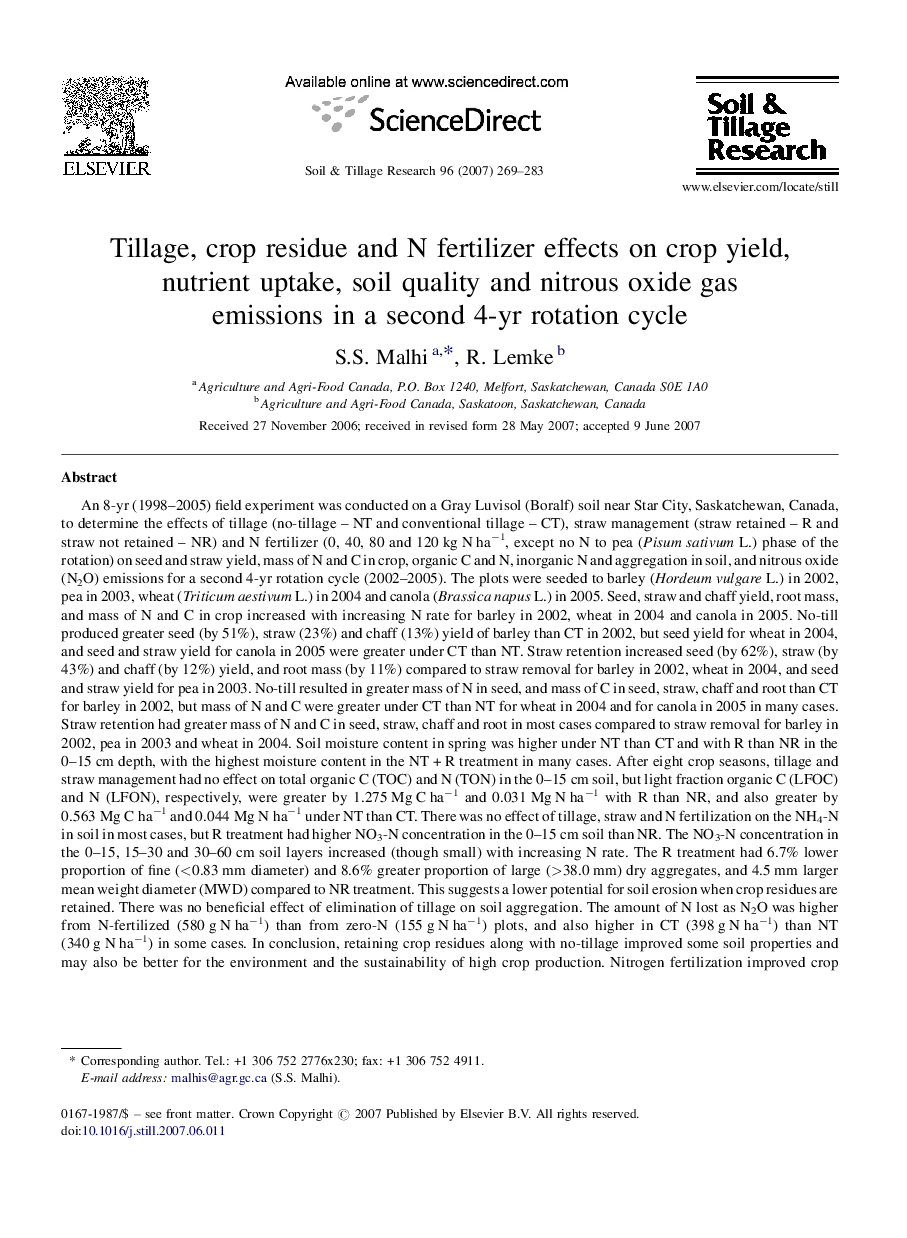| کد مقاله | کد نشریه | سال انتشار | مقاله انگلیسی | نسخه تمام متن |
|---|---|---|---|---|
| 306555 | 513101 | 2007 | 15 صفحه PDF | دانلود رایگان |

An 8-yr (1998–2005) field experiment was conducted on a Gray Luvisol (Boralf) soil near Star City, Saskatchewan, Canada, to determine the effects of tillage (no-tillage – NT and conventional tillage – CT), straw management (straw retained – R and straw not retained – NR) and N fertilizer (0, 40, 80 and 120 kg N ha−1, except no N to pea (Pisum sativum L.) phase of the rotation) on seed and straw yield, mass of N and C in crop, organic C and N, inorganic N and aggregation in soil, and nitrous oxide (N2O) emissions for a second 4-yr rotation cycle (2002–2005). The plots were seeded to barley (Hordeum vulgare L.) in 2002, pea in 2003, wheat (Triticum aestivum L.) in 2004 and canola (Brassica napus L.) in 2005. Seed, straw and chaff yield, root mass, and mass of N and C in crop increased with increasing N rate for barley in 2002, wheat in 2004 and canola in 2005. No-till produced greater seed (by 51%), straw (23%) and chaff (13%) yield of barley than CT in 2002, but seed yield for wheat in 2004, and seed and straw yield for canola in 2005 were greater under CT than NT. Straw retention increased seed (by 62%), straw (by 43%) and chaff (by 12%) yield, and root mass (by 11%) compared to straw removal for barley in 2002, wheat in 2004, and seed and straw yield for pea in 2003. No-till resulted in greater mass of N in seed, and mass of C in seed, straw, chaff and root than CT for barley in 2002, but mass of N and C were greater under CT than NT for wheat in 2004 and for canola in 2005 in many cases. Straw retention had greater mass of N and C in seed, straw, chaff and root in most cases compared to straw removal for barley in 2002, pea in 2003 and wheat in 2004. Soil moisture content in spring was higher under NT than CT and with R than NR in the 0–15 cm depth, with the highest moisture content in the NT + R treatment in many cases. After eight crop seasons, tillage and straw management had no effect on total organic C (TOC) and N (TON) in the 0–15 cm soil, but light fraction organic C (LFOC) and N (LFON), respectively, were greater by 1.275 Mg C ha−1 and 0.031 Mg N ha−1 with R than NR, and also greater by 0.563 Mg C ha−1 and 0.044 Mg N ha−1 under NT than CT. There was no effect of tillage, straw and N fertilization on the NH4-N in soil in most cases, but R treatment had higher NO3-N concentration in the 0–15 cm soil than NR. The NO3-N concentration in the 0–15, 15–30 and 30–60 cm soil layers increased (though small) with increasing N rate. The R treatment had 6.7% lower proportion of fine (<0.83 mm diameter) and 8.6% greater proportion of large (>38.0 mm) dry aggregates, and 4.5 mm larger mean weight diameter (MWD) compared to NR treatment. This suggests a lower potential for soil erosion when crop residues are retained. There was no beneficial effect of elimination of tillage on soil aggregation. The amount of N lost as N2O was higher from N-fertilized (580 g N ha−1) than from zero-N (155 g N ha−1) plots, and also higher in CT (398 g N ha−1) than NT (340 g N ha−1) in some cases. In conclusion, retaining crop residues along with no-tillage improved some soil properties and may also be better for the environment and the sustainability of high crop production. Nitrogen fertilization improved crop production and some soil quality attributes, but also increased the potential for NO3-N leaching and N2O-N emissions, especially when applied in excess of crop requirements.
Journal: Soil and Tillage Research - Volume 96, Issues 1–2, October 2007, Pages 269–283